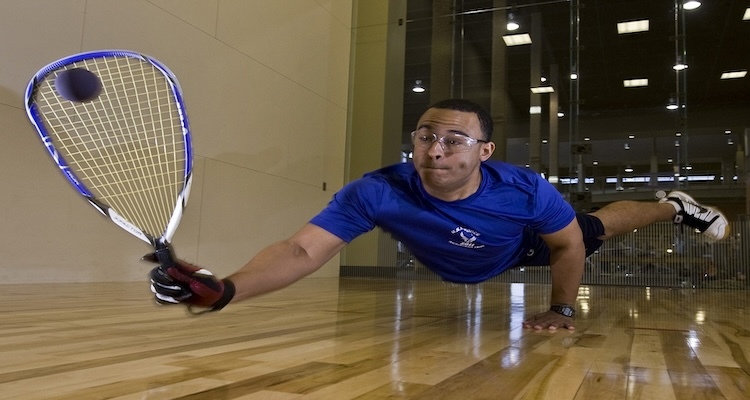
Racquetball, a dynamic and exhilarating sport, has gained immense popularity among fitness enthusiasts seeking a comprehensive workout that challenges both their physical and mental abilities. This high-intensity game not only provides an adrenaline-fueled experience but also offers a plethora of benefits that contribute to overall health and well-being.
Played on an enclosed court, racquetball demands a combination of agility, power, and strategic thinking, making it an excellent choice for individuals seeking a full-body workout. Unlike many traditional exercises, racquetball engages multiple muscle groups simultaneously, ensuring a well-rounded fitness regimen.
Racquetball is a dynamic and multifaceted sport that engages virtually every muscle group in the body, providing a comprehensive workout that targets both strength and endurance. From explosive bursts of energy to sustained periods of intense activity, this fast-paced game demands a high level of physical exertion, ensuring that no muscle group is left untouched.
As you navigate the court, your body is constantly in motion, pivoting, lunging, and reaching to return the ball with precision and power. Each shot requires a coordinated effort from various muscle groups, creating a synergistic effect that maximizes the effectiveness of your workout.
The unique nature of racquetball lies in its ability to seamlessly blend cardiovascular exercise with strength training, resulting in a truly holistic fitness experience.
Racquetball is a true test of upper body strength and endurance, engaging a multitude of muscles from your shoulders to your forearms. As you swing the racquet with explosive force, your deltoids (shoulder muscles), pectorals (chest muscles), and triceps (back of the arms) work in tandem to generate power and control.
While the upper body plays a significant role in racquetball, the lower body muscles are equally crucial for generating power, maintaining balance, and enabling quick movements across the court. From explosive lunges to rapid directional changes, your lower body muscles are put to the test in every rally.
While racquetball undoubtedly challenges your muscular strength and endurance, it also provides an exceptional cardiovascular workout, making it an ideal choice for individuals seeking to improve their overall fitness levels.
The fast-paced nature of the game, coupled with the constant movement required to retrieve and return the ball, elevates your heart rate and keeps it elevated throughout the duration of the game. This sustained increase in heart rate and respiration rate is a hallmark of an effective cardiovascular workout, promoting improved cardiovascular health and endurance.
Unlike some traditional cardio exercises, such as running or cycling, racquetball offers a dynamic and engaging environment that can help alleviate boredom and maintain motivation. The competitive nature of the game, combined with the need for strategic thinking and quick reactions, adds an element of mental stimulation that can enhance the overall workout experience.
One of the most appealing aspects of racquetball is its ability to burn a significant number of calories in a relatively short period of time. The intense nature of the game, combined with the engagement of multiple muscle groups, results in a high caloric expenditure, making it an excellent choice for individuals seeking to achieve weight loss or maintain a healthy body composition.
According to various studies, a person weighing approximately 155 pounds can burn anywhere between 500 to 800 calories during an hour of competitive racquetball play. This caloric burn rate is comparable to or even higher than many other popular cardio exercises, such as running, cycling, or swimming.
However, it's important to note that the exact number of calories burned during a racquetball session can vary depending on factors such as individual fitness level, intensity of play, and duration of the game. Nonetheless, the combination of cardiovascular exercise and strength training inherent in racquetball makes it an effective tool for achieving a caloric deficit and promoting weight management.
While the physical benefits of racquetball are undeniable, this dynamic sport also offers a range of additional advantages that contribute to overall well-being.
To maximize the benefits of racquetball and ensure a safe and effective workout, it's essential to follow a few key tips:
To ensure a successful and enjoyable racquetball experience, proper preparation is key. Here are some essential steps to take before hitting the court:
Racquetball is a dynamic and exhilarating sport that offers a truly comprehensive workout, engaging virtually every muscle group in the body while simultaneously providing an exceptional cardiovascular challenge. From the explosive movements required to return powerful shots to the sustained periods of intense activity, racquetball demands a high level of physical exertion, ensuring that no muscle group is left untouched.
By embracing the power of racquetball, you'll not only sculpt a strong and resilient physique but also experience the thrill of friendly competition, the joy of social interaction, and the mental benefits of stress relief and improved focus. Whether you're a seasoned athlete or a newcomer to the world of racquet sports, racquetball promises to challenge you in ways you never imagined, all while delivering an exhilarating and enjoyable experience.
Discover a local racquetball club or court near you and experience the unparalleled benefits of this dynamic sport firsthand. Embrace the power of racquetball and embark on a path towards a stronger, leaner, and more resilient you.
